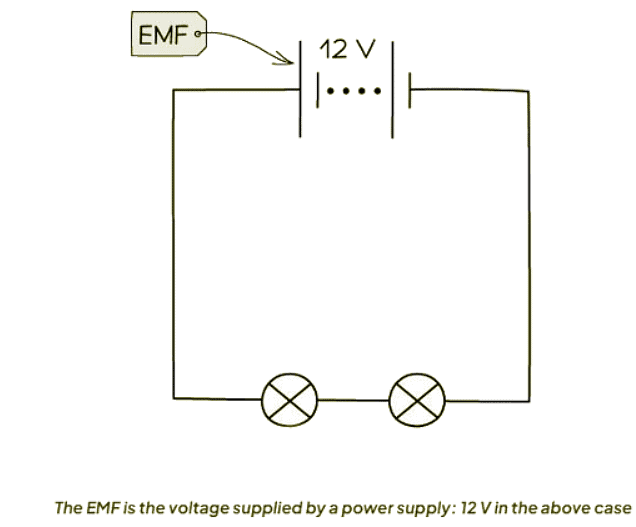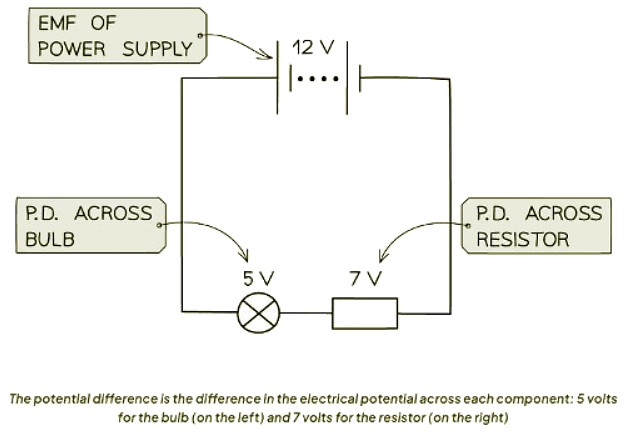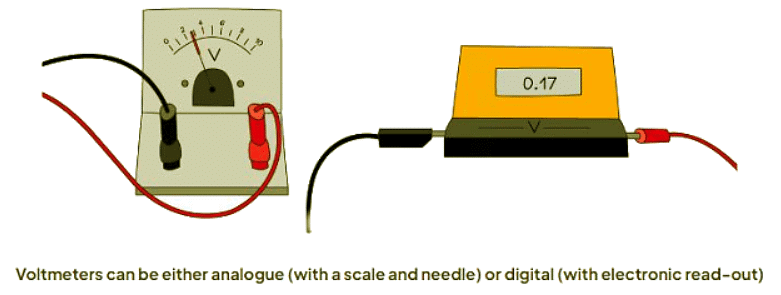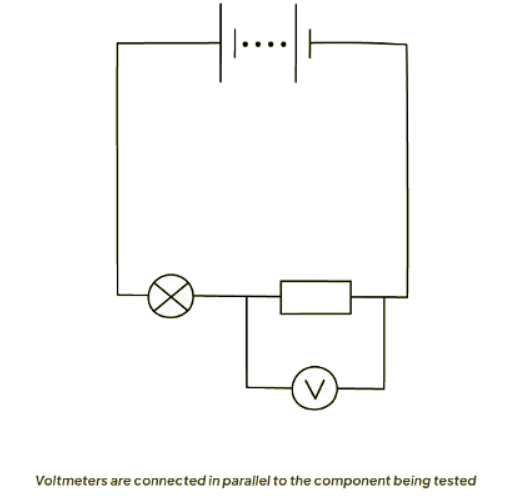Class 10 Exam > Class 10 Notes > Physics for GCSE/IGCSE > Electromotive Force & Potential Difference
Electromotive Force & Potential Difference | Physics for GCSE/IGCSE - Class 10 PDF Download
Electromotive Force
- The concept of electromotive force (e.m.f.) refers to the potential difference provided by a power source within a circuit.
- It can be defined as the electrical work executed by a source when moving a unit charge throughout a complete circuit.
- Electromotive force is typically measured in volts (V).

- The definition of electromotive force can also be expressed using an equation.

- In this equation,
- E represents electromotive force (e.m.f.) in volts (V),
- W stands for the energy supplied to charges from the power source in joules (J), and
- Q signifies the charge on each charge carrier in coulombs (C).
Note: In circuits, the charge carriers are electrons.
- This equation should be compared to the definition of potential difference as they are closely related.
Potential Difference
- As electric charge moves around a circuit, energy is transferred from the power source to the charge carriers, and subsequently to the components.
- This energy transfer is what causes components like bulbs to light up.
- The potential difference between two points in a circuit is directly related to the amount of energy transferred between those points.
- Potential difference is defined as the work done by a unit charge passing through a component.
- Potential difference is measured in volts (V)

- The definition of potential difference can also be represented using an equation.

- Where,
- V represents potential difference (p.d.) in volts,
- W signifies energy transferred to the components from the charge carriers in joules, and
- Q is the charge on each charge carrier in coulombs.
- In electrical circuits, the charge carriers are electrons. It's important to compare this equation to the electromotive force (e.m.f.) definition, as both are interconnected due to energy conservation principles.
Question for Electromotive Force & Potential DifferenceTry yourself: What is the definition of electromotive force (e.m.f.)?View Solution
Measuring Potential Difference
- Potential difference is measured using a voltmeter, which can be either Digital (with an electronic readout) or Analogue (with a needle and scale).
- Voltmeters are connected in parallel with the component being tested, ensuring accurate voltage readings.
- The potential difference is the electrical potential variance between two points, necessitating connection of the voltmeter to these points in the circuit.
Analogue or Digital?
- Analogue voltmeters are susceptible to parallax error, a phenomenon where the position of the observer affects the reading. To mitigate this error, it is crucial to view the meter from a position directly perpendicular to the scale.
- Typical ranges for analogue voltmeters span from 0.1-1.0 V to 0-5.0 V, although these ranges can vary.
- Before conducting an experiment, it is imperative to verify the marker's position on the scale. If it deviates from zero, adjustments are necessary to ensure measurement accuracy.
- Additionally, zero errors should be rectified before utilizing the voltmeter.
- Key Points: Always read the meter from a position directly perpendicular to the scale

- Digital voltmeters can measure very small potential differences, in millivolts (mV) or microvolts (µV).
- Digital displays provide more accurate readings compared to analogue displays.
- They are user-friendly, showing specific values and capable of displaying precise measurements.
- However, digital displays may fluctuate between values, requiring judgment for recording.
- Check digital voltmeters for zero error; ensure a zero reading before experiments or adjust results accordingly.

The document Electromotive Force & Potential Difference | Physics for GCSE/IGCSE - Class 10 is a part of the Class 10 Course Physics for GCSE/IGCSE.
All you need of Class 10 at this link: Class 10
|
126 videos|182 docs|35 tests
|
FAQs on Electromotive Force & Potential Difference - Physics for GCSE/IGCSE - Class 10
| 1. What is electromotive force (emf) in a circuit? |  |
Ans. Electromotive force (emf) is the energy per unit charge supplied by a source of electrical energy, such as a battery, to move the charge around a complete circuit.
| 2. How is potential difference different from electromotive force? |  |
Ans. Potential difference is the energy transferred per unit charge as a charge moves between two points in a circuit, while electromotive force is the energy per unit charge supplied by the source of electrical energy.
| 3. How can potential difference be measured in a circuit? |  |
Ans. Potential difference can be measured using a voltmeter, which is connected across the component or points in a circuit where the potential difference needs to be measured.
| 4. What is the difference between analogue and digital voltmeters in measuring potential difference? |  |
Ans. Analogue voltmeters use a moving pointer on a scale to indicate the potential difference, while digital voltmeters provide a numerical display of the potential difference in volts.
| 5. Why is it important to measure potential difference in a circuit? |  |
Ans. Measuring potential difference helps to determine the voltage across components in a circuit, which is crucial for understanding the flow of current and ensuring the proper functioning of the circuit.
Related Searches















